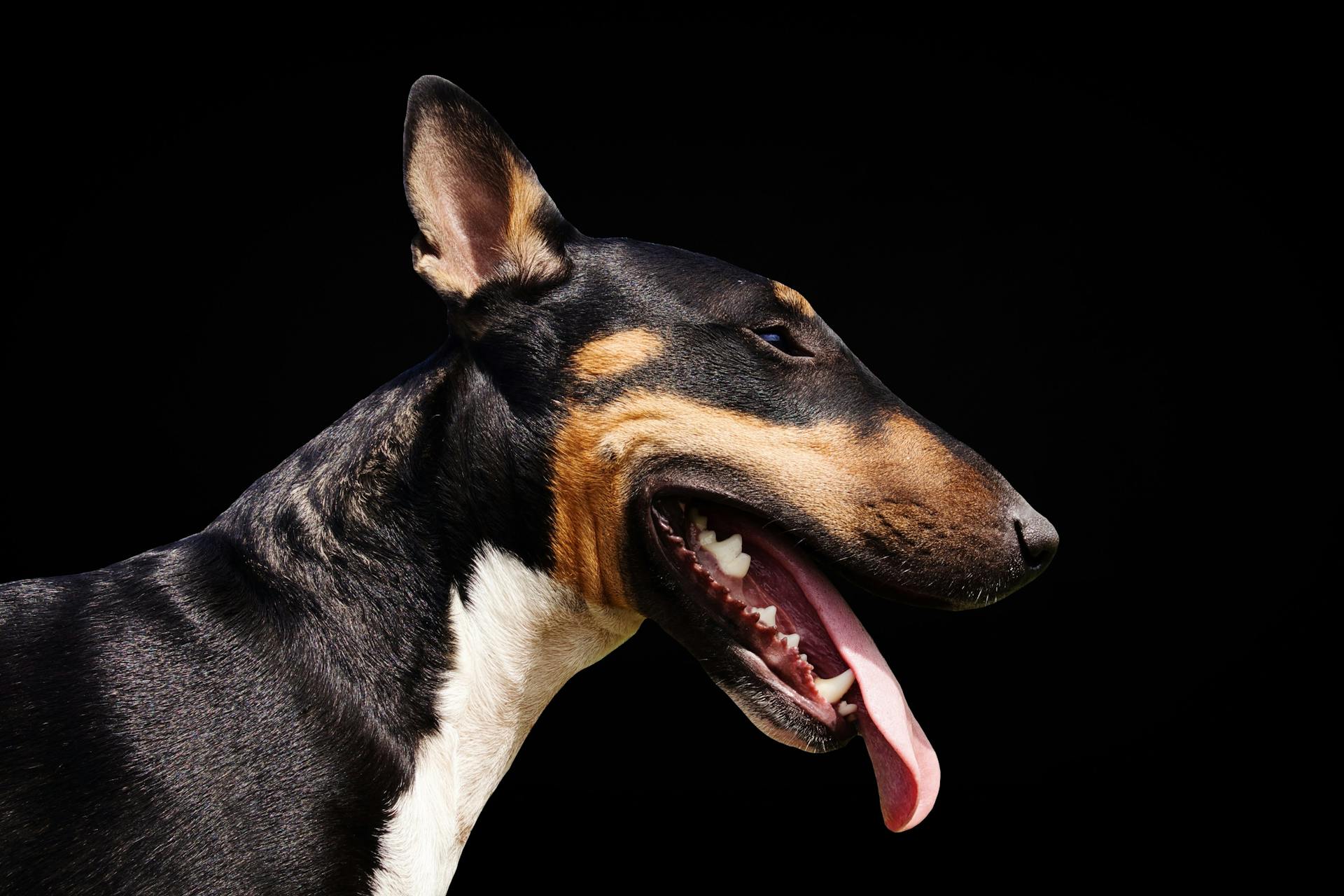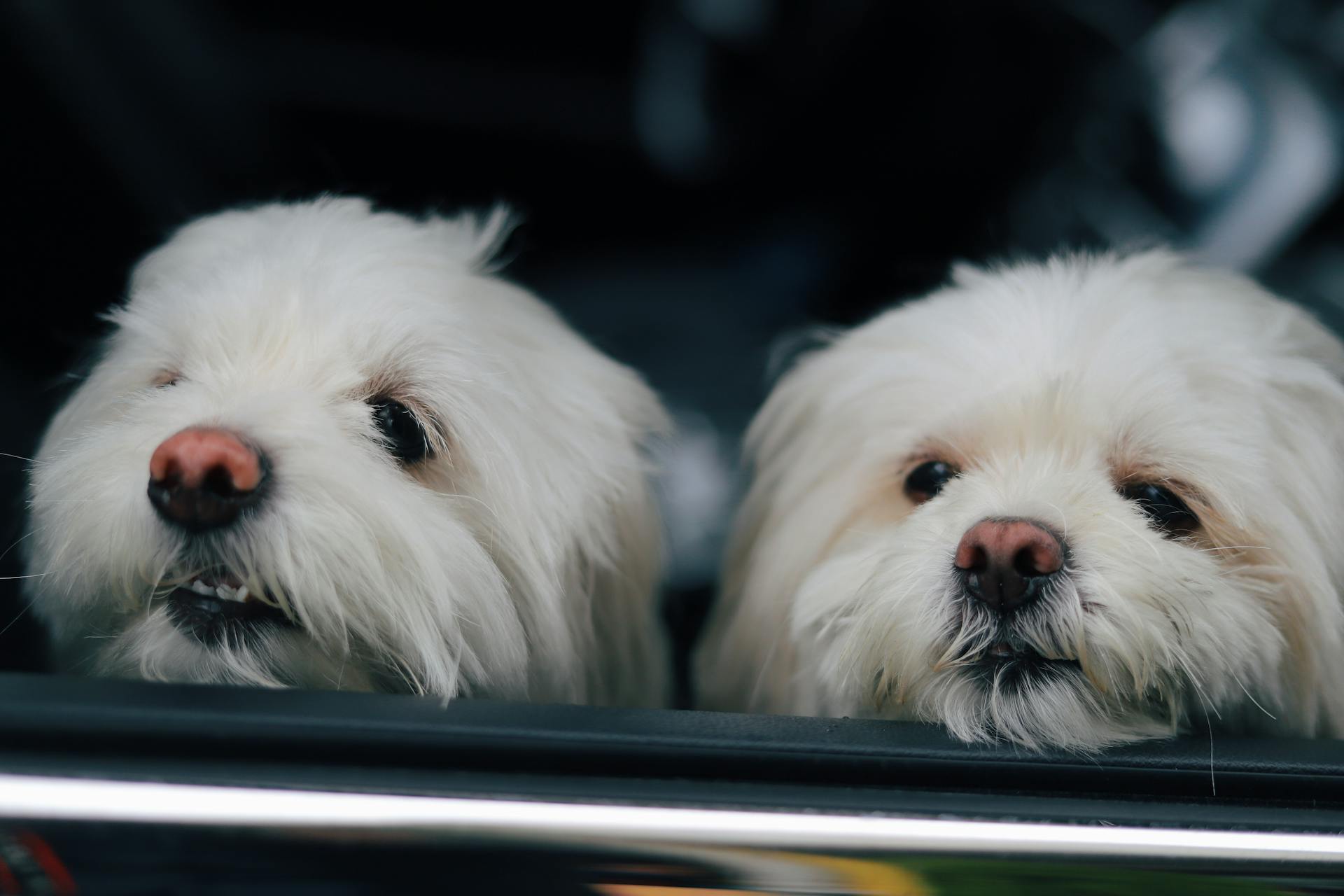
A hard lump on your dog's tail can be a worrying sight. This lump can be a sign of a variety of issues, ranging from minor skin irritations to more serious health problems.
The size and location of the lump can provide clues about its cause. A lump on the base of the tail is more likely to be related to anal gland issues or skin infections, while a lump further up the tail may be a sign of a skin abscess or a tumor.
In some cases, a hard lump on the tail can be a sign of a condition called anal gland disease, which affects the glands located on either side of the anus. This condition can cause painful swelling, redness, and discharge.
A dog's tail is a sensitive area, and any lump or swelling can be a source of discomfort for your pet. Regular grooming and veterinary check-ups can help identify potential issues before they become serious problems.
If this caught your attention, see: Why Does My Dog Wag Its Tail
What Are Lumps on Dogs?
Lumps on dogs can be caused by infections and abscesses, which are most common on the paws, face, neck, tail, and anal sacs. These can sometimes burst and drain pus.
A lump on your dog's tail could be a fatty lump, or lipoma, which is common in older and overweight dogs and is almost always benign. They're often very soft to the touch and move freely under the skin.
Some lumps on dogs are due to a tumour or growth, which can be benign or cancerous. A vet assessment is recommended to determine the cause.
Lymphoma can cause swelling of one or more lymph nodes, resulting in lumps under the skin. This should be assessed by a vet as soon as possible.
Cysts related to the sebaceous glands and hair follicles are common and not usually dangerous, but can cause irritation and get infected.
On a similar theme: Bull Terrier Skin Issues
Causes and Types of Lumps
Lumps on a dog's skin can be caused by a variety of factors, including genetic predisposition, injury or trauma, blockage of a follicle opening, and hormonal imbalance.
Sebaceous cysts, for example, are prone to secondary infection and can be painful. They can also emit a foul odor or pus.
Some common causes of lumps on dogs include infections and abscesses, which can appear on the paws, face, neck, tail, and anal sacs. Allergic reactions can also cause lumps, often manifesting as red, raised wheals on the dog's body.
Here are some types of lumps that can occur on a dog's skin:
- Sebaceous gland adenoma/epithelioma
- Sebaceous gland hamartoma
- Sebaceous gland adenocarcinoma
Causes of Lumps
Lumps on dogs can be caused by a variety of factors, including infections and abscesses. These are most common on the paws, face, neck, tail, and anal sacs, and can sometimes burst and drain pus.
Infections and abscesses are not the only possible causes of lumps on dogs. Allergic reactions can also cause multiple red, raised wheals all over the dog's body, especially on their back and sides.
Lumps can also be due to a tumour or growth. Many of these are benign, such as warts, but cancerous lumps are still common. A vet assessment is recommended, especially if the lump is red, sore, or growing rapidly.
A fresh viewpoint: Ear Infections in Goldendoodles

Fatty lumps, or lipomas, are common in older and overweight dogs and are almost always benign. They are often very soft to the touch and move freely under the skin.
Here are some possible causes of lumps on dogs:
- Infections and abscesses
- Allergic reactions
- Tumours or growths
- Fatty lumps (lipomas)
- Cysts related to the sebaceous glands and hair follicles
- Umbilical and inguinal hernias
It's essential to note that some lumps can be more serious than others, and a vet assessment is always recommended to determine the cause and appropriate treatment.
Fibrosarcomas
Fibrosarcomas are common, fast-growing malignant tumors in dogs, often found on the trunk and legs.
They can appear lumpy under the skin's surface or firm and fleshy if deep under the skin.
Fibrosarcomas can invade underlying muscles, but most do not spread to other areas of the body.
Treatment typically involves surgical removal, although complete removal may not be possible, and regrowth is common.
Fibrosarcomas may also be treated with radiation and chemotherapy.
Readers also liked: Lump under Skin after Dog Bite on Dog
Diagnosing Lumps and Bumps in Vets
When finding a growth on your dog, it's essential to have your vet do a physical exam to determine the location, size, and appearance of the lump. Your vet will also ask about the history of the lump, including how long it's been there and any changes that have occurred.
Taking a series of photographs can be helpful for your veterinarian to make a diagnosis. This can help your vet see the lump from different angles and take note of any changes over time.
A vet may use various methods to diagnose the lump, including taking an impression of the surface, using a syringe and small needle to withdraw a small sample of cells (FNA), or surgically removing a small tissue sample (biopsy).
Most veterinarians evaluate impression smears or fine needle aspirates by staining the slide and examining it under a microscope in the veterinary office. Trained veterinary pathologists are available to analyze these samples or small tissue samples to determine a diagnosis.
A physical exam can help your veterinarian determine the location, number, and appearance of the lump. Your vet may also take a urinalysis and blood work to check for any underlying health issues.
A fine-needle aspirate or biopsy may be necessary to determine the nature of the lump. This involves removing a tissue sample from the lump and examining it under a microscope to determine the type of growth.
Here are some common methods used to diagnose lumps and bumps in dogs:
- Physical exam
- Impression smears or fine needle aspirates
- Biopsy
- Urinalysis and blood work
Symptoms and What to Do
If your dog has a hard lump on their tail, it's essential to monitor their behavior and physical condition. A lump can be a sign of an underlying issue, such as an infection, abscess, or tumor.
A lump on your dog's tail can cause discomfort and pain, especially if it's inflamed or infected. If your dog is showing signs of pain or distress, such as whining or avoiding the area, seek veterinary attention immediately.
The size and shape of the lump can vary greatly, from less than ½ an inch to over 2 inches in diameter, and can be round or elongated. You may also notice that the lump is slightly mobile under the skin.
If the lump is bleeding, apply gentle pressure to the area for 60 seconds, and if the bleeding continues or is severe, contact a vet straight away. It's also crucial to monitor your dog's overall health, including their appetite and weight, as changes in these areas could indicate a more serious issue.
Here are some key things to look out for:
- Pain or discomfort in the affected area
- Inflammation or redness around the lump
- Bleeding or discharge from the lump
- Changes in appetite or weight
- Sudden changes in the lump's size or shape
Symptoms

A sebaceous cyst on your furry friend can be a bit of a mystery, but recognizing the symptoms can help you catch it early.
The appearance of a sebaceous cyst can vary, but you might notice a raised area of skin or a nodule.
Cysts can be round or elongated, and some may even be slightly mobile under the skin.
The size of a cyst can range from less than ½ an inch to over 2 inches in diameter.
You might see multiple growths on your dog's skin.
Inflammation can occur around the cyst, which can be a sign that something's not quite right.
A cyst can become infected, which can lead to more serious issues.
A cyst may bleed, which can be alarming, but it's not usually a cause for concern.
You might notice a yellow substance oozing from the cyst, which is a sign that it's infected or inflamed.
Expand your knowledge: Canine Skin Cancer Photos
What to Do If You Find a Lump

If you find a lump on your dog, it's essential to act quickly. Contact a vet for further advice immediately if the lump is painful or your dog is otherwise unwell.
A bleeding lump requires gentle pressure for 60 seconds, but if the bleeding continues or is severe, seek vet help right away.
Monitor your dog closely if they're completely normal apart from the lump, taking note of any changes in size, color, or texture. It's also helpful to measure the lump and take photos of the area.
If you notice any changes in your dog's appetite or weight, it could be a sign of something more serious, so consult a vet promptly.
A lump that has been present for a while but suddenly changes should be checked as soon as possible.
Here are some key signs to look out for:
- Painful lumps
- Inflamed lumps
- Lumps that bother your dog
- Changes in appetite or weight loss
Take pictures and note any changes from day to day in these factors. Make an appointment with your vet as soon as possible and bring your log and photos along with any questions you may have.
Recovery and Advice
Your dog's recovery from a hard lump on their tail will depend on the type of lump and its severity. If the lump is cancerous, you'll need to follow up with your veterinarian to ensure the cancer is being eradicated.
You'll be required to keep the area clean, but you won't be allowed to bathe your dog until the veterinarian gives permission.
An Elizabethan collar may be necessary to prevent your dog from licking or biting the area as it heals.
A different take: Why Is My Male Dogs Private Area Swollen and Red
Frequently Asked Questions
Are cancerous lumps on dogs hard or soft?
Cancerous lumps on dogs are typically hard and firm to the touch, unlike the soft and fatty characteristics of non-cancerous lumps. If you suspect a lump on your dog, it's essential to have it evaluated by a veterinarian for proper diagnosis and treatment.
What does a cyst look like on a dog's tail?
A cyst on a dog's tail appears as a hard, round nodule, often with a bluish color and a thick, cheesy texture. If infected, it may also have a foul smell and produce discharge
Sources
- https://www.merckvetmanual.com/integumentary-system/tumors-of-the-skin-and-soft-tissues/connective-tissue-tumors-in-animals
- https://www.petmd.com/dog/symptoms/lumps-bumps-and-cysts-dogs
- https://wagwalking.com/condition/sebaceous-cysts
- https://www.joiipetcare.com/health-conditions/dog/lumps/
- https://wagwalking.com/condition/perianal-gland-tumor
Featured Images: pexels.com


